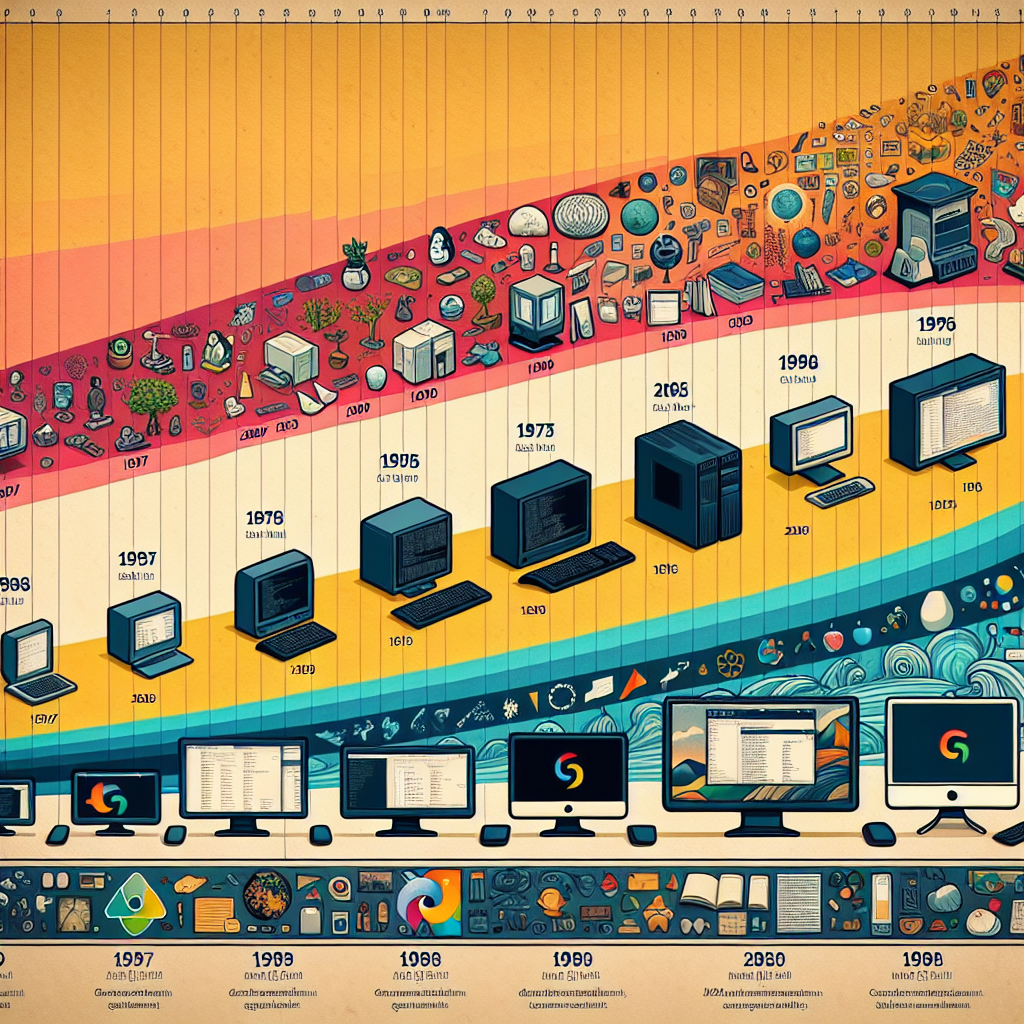Historical Development of KDE and GNOME: Key Milestones and Divergent Paths
The evolution of the KDE and GNOME desktop environments represents a fascinating journey through the world of open-source software, highlighting both collaborative and competitive elements that have driven innovation and user experience. These environments have not only shaped the way users interact with their Linux systems but have also influenced each other, leading to significant advancements in desktop environment design and functionality.
KDE, short for K Desktop Environment, was launched in 1996, with the aim of creating a cohesive, attractive, and easy-to-use desktop environment for Unix-like operating systems. Its development was marked by the use of the Qt toolkit, which provided the necessary framework for building the graphical user interface elements. One of the key milestones in KDE’s history was the release of KDE 1.0 in 1998, which offered users a functional and visually appealing interface, setting a high standard for future developments.
In contrast, GNOME, which stands for GNU Network Object Model Environment, was initiated in 1999 as an alternative to KDE, primarily due to licensing concerns surrounding the Qt toolkit used by KDE, which at the time was not fully free software. GNOME opted for the GTK toolkit, which is completely open source. This decision underscored GNOME’s commitment to freedom in software development, aligning closely with the principles of the GNU Project. The release of GNOME 1.0 in 1999 marked the beginning of its journey to provide a free and user-friendly desktop environment.
As KDE and GNOME evolved, their paths diverged further, influenced by different design philosophies and user interface priorities. KDE has been known for its configurability, offering a plethora of options to customize the desktop experience. Its Plasma desktop, introduced with KDE 4 in 2008, brought a modern and highly customizable interface that could be tailored to personal preferences, from widgets to window behavior. KDE’s development has consistently focused on integrating the latest technology advancements, making it a favorite among users who enjoy tweaking and personalizing their computing environment.
On the other hand, GNOME has focused on simplicity and ease of use, with a design philosophy that emphasizes minimalism and efficiency. The release of GNOME 2 in 2002 was a significant step forward in achieving a streamlined and user-friendly desktop. However, it was GNOME 3, launched in 2011, that truly redefined its approach. With its GNOME Shell interface, it introduced a new way of interacting with the desktop, prioritizing a clutter-free and intuitive user experience. This approach has sometimes been polarizing, with some users preferring the older, more traditional paradigms offered by other environments, including KDE.
Despite their differences, both KDE and GNOME have contributed to the broader Linux community. They have fostered innovation through competition and collaboration, influencing not only each other but also other desktop environments and open-source projects. For instance, elements of GNOME’s design have found their way into other interfaces, just as KDE’s technologies have been adopted by various software developers for their flexibility and robustness.
In conclusion, the historical development of KDE and GNOME illustrates a broader narrative of open-source software development, where diverse philosophies and user needs drive the creation of varied solutions. Each environment continues to evolve, shaped by its community and the ongoing dialogue between configurability and simplicity. As they move forward, KDE and GNOME remain at the heart of the Linux desktop conversation, each offering a distinct choice that caters to different preferences and priorities in the ever-evolving landscape of technology.
Comparative Analysis of KDE and GNOME: User Interface Design and Usability Features

The KDE and GNOME desktop environments are two of the most popular and enduring user interfaces in the world of Linux. Each has evolved significantly over the years, developing unique characteristics that cater to different user preferences and usability paradigms. This comparative analysis delves into the nuances of their user interface design and usability features, highlighting how they distinguish from one another.
KDE, short for K Desktop Environment, was first introduced in 1998. It is known for its configurability and an eye-catching graphical interface that resembles a traditional desktop model. KDE’s Plasma desktop is highly customizable, allowing users to modify almost every aspect of their experience, from the behavior of windows to the look and feel of the desktop itself. This level of customization makes KDE particularly appealing to users who enjoy tailoring their computing environment to fit their specific needs and preferences.
Transitioning from KDE’s adaptability, GNOME takes a different approach with a focus on simplicity and ease of use. Launched in 1999, GNOME aims to provide a clean and straightforward user experience. It adopts a minimalist design philosophy, eschewing unnecessary options in favor of accessibility and efficiency. The GNOME Shell, introduced with GNOME 3, emphasizes a sleek interface that prioritizes workflow and productivity. Its design eliminates traditional menus and minimizes screen clutter, which can help users focus on their tasks without distractions.
The user interface design of KDE and GNOME not only reflects their aesthetic differences but also influences how users interact with their systems. KDE’s interface is often celebrated for its powerful tools and widgets that can be added to the desktop, offering functionality that can be accessed quickly and easily. This can be particularly beneficial for power users who need immediate access to a wide range of functionalities. In contrast, GNOME’s streamlined design philosophy might be less overwhelming for new users or those who prefer a cleaner, more organized desktop.
Moreover, the usability features of KDE and GNOME are tailored to different types of workflows. KDE’s Plasma desktop supports activities, allowing users to switch between different desktop configurations depending on the task at hand. This can be incredibly useful for users who perform a variety of tasks that require different tools and resources. On the other hand, GNOME’s Activities Overview provides an easy way to view all open windows and virtual desktops, making it simple to manage multiple tasks simultaneously. This feature is particularly useful for users who need to multitask efficiently but prefer not to adjust their environment drastically.
In terms of performance, both KDE and GNOME have made significant strides in optimizing speed and resource usage. KDE has worked on reducing its traditionally heavy resource consumption, making it more comparable to GNOME, which has consistently aimed for efficiency. Both environments now offer versions that can run smoothly on lower-end hardware, broadening their appeal.
In conclusion, the evolution of KDE and GNOME has led to the development of two distinct desktop environments, each with its own set of strengths and philosophies regarding user interface design and usability. KDE offers a highly customizable experience suited for users who like to control every aspect of their desktop environment, while GNOME focuses on providing a simple, efficient interface that appeals to users who appreciate minimalism and ease of use. As both environments continue to evolve, they remain at the forefront of open-source software, offering compelling choices for diverse user needs.
Future Trends in KDE and GNOME: Innovations and Expected Developments in Open Source Desktop Environments
The KDE and GNOME desktop environments have long been at the forefront of open-source interface design, offering users robust alternatives to proprietary systems. As we look towards the future, both environments are poised to continue their evolution, driven by active communities and a shared commitment to innovation. Understanding the trajectory of these developments not only highlights the dynamic nature of open-source projects but also helps in distinguishing the unique paths KDE and GNOME are likely to take.
KDE, known for its Plasma desktop, has consistently focused on a customizable user experience. Its framework is built to be modular, allowing users to tweak almost every aspect of their interface. As technology progresses, KDE developers are increasingly integrating cutting-edge features that enhance user interaction and system performance. One of the anticipated trends in KDE’s development is the deeper incorporation of Qt technologies, particularly with the upcoming Qt 6 framework. This integration promises to deliver more fluid and graphically cohesive applications, enhancing user experience with smoother animations and transitions.
Moreover, KDE is expected to push the boundaries of conventional desktop environments by expanding its reach into virtual and augmented reality. This innovative leap could transform the way users interact with their desktops, offering more immersive and interactive experiences. The focus on VR and AR also suggests KDE’s commitment to staying relevant in a rapidly changing tech landscape, where virtual interfaces may become as common as traditional ones.
Transitioning to GNOME, this desktop environment is known for its minimalist design philosophy, which contrasts with KDE’s customization ethos. GNOME’s approach is about streamlining and simplifying the user experience, making it accessible and efficient. Future developments in GNOME are likely to emphasize further usability enhancements, particularly through improvements in human interface guidelines (HIG). These guidelines are crucial for creating a consistent and intuitive user experience across all GNOME applications.
Another significant area of focus for GNOME is the integration of machine learning and artificial intelligence. By leveraging these technologies, GNOME aims to offer smarter, context-aware functionalities that can predict user needs and automate routine tasks. This could lead to a more adaptive and responsive desktop environment, which not only increases productivity but also redefines user interaction with their machines.
Both KDE and GNOME are also placing a strong emphasis on sustainability and performance optimization. With the increasing awareness of technology’s environmental impact, both projects are optimizing their software to be more energy-efficient, which is particularly important for users with older hardware or those in regions with limited power resources. Additionally, as open-source projects, both KDE and GNOME are continuously improving their security features, recognizing the importance of robust security measures in maintaining user trust and ensuring system integrity.
In conclusion, the future trends in KDE and GNOME are shaped by both their philosophical underpinnings and the demands of the evolving technological landscape. While KDE is likely to enhance its customization capabilities and explore new interactive frontiers like VR and AR, GNOME is set to refine its minimalist approach with smarter, more intuitive functionalities. These developments not only reflect the distinct identities of each environment but also underscore the vibrant innovation inherent in the open-source community. As these environments evolve, they continue to offer compelling choices for users, each with its unique strengths and visions for the future of desktop computing.
Discover more from Rune Slettebakken
Subscribe to get the latest posts sent to your email.


